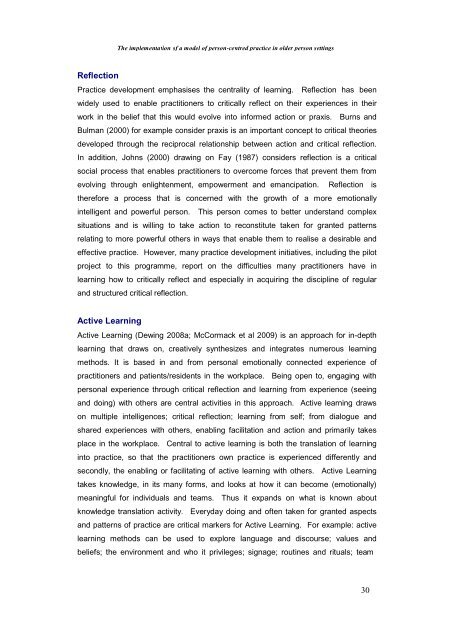The Implementation of a Model of Person-Centred Practice In Older ...
The Implementation of a Model of Person-Centred Practice In Older ...
The Implementation of a Model of Person-Centred Practice In Older ...
You also want an ePaper? Increase the reach of your titles
YUMPU automatically turns print PDFs into web optimized ePapers that Google loves.
<strong>The</strong> implementation <strong>of</strong> a model <strong>of</strong> person-centred practice in older person settings<br />
Reflection<br />
<strong>Practice</strong> development emphasises the centrality <strong>of</strong> learning. Reflection has been<br />
widely used to enable practitioners to critically reflect on their experiences in their<br />
work in the belief that this would evolve into informed action or praxis. Burns and<br />
Bulman (2000) for example consider praxis is an important concept to critical theories<br />
developed through the reciprocal relationship between action and critical reflection.<br />
<strong>In</strong> addition, Johns (2000) drawing on Fay (1987) considers reflection is a critical<br />
social process that enables practitioners to overcome forces that prevent them from<br />
evolving through enlightenment, empowerment and emancipation. Reflection is<br />
therefore a process that is concerned with the growth <strong>of</strong> a more emotionally<br />
intelligent and powerful person. This person comes to better understand complex<br />
situations and is willing to take action to reconstitute taken for granted patterns<br />
relating to more powerful others in ways that enable them to realise a desirable and<br />
effective practice. However, many practice development initiatives, including the pilot<br />
project to this programme, report on the difficulties many practitioners have in<br />
learning how to critically reflect and especially in acquiring the discipline <strong>of</strong> regular<br />
and structured critical reflection.<br />
Active Learning<br />
Active Learning (Dewing 2008a; McCormack et al 2009) is an approach for in-depth<br />
learning that draws on, creatively synthesizes and integrates numerous learning<br />
methods. It is based in and from personal emotionally connected experience <strong>of</strong><br />
practitioners and patients/residents in the workplace. Being open to, engaging with<br />
personal experience through critical reflection and learning from experience (seeing<br />
and doing) with others are central activities in this approach. Active learning draws<br />
on multiple intelligences; critical reflection; learning from self; from dialogue and<br />
shared experiences with others, enabling facilitation and action and primarily takes<br />
place in the workplace. Central to active learning is both the translation <strong>of</strong> learning<br />
into practice, so that the practitioners own practice is experienced differently and<br />
secondly, the enabling or facilitating <strong>of</strong> active learning with others. Active Learning<br />
takes knowledge, in its many forms, and looks at how it can become (emotionally)<br />
meaningful for individuals and teams. Thus it expands on what is known about<br />
knowledge translation activity. Everyday doing and <strong>of</strong>ten taken for granted aspects<br />
and patterns <strong>of</strong> practice are critical markers for Active Learning. For example: active<br />
learning methods can be used to explore language and discourse; values and<br />
beliefs; the environment and who it privileges; signage; routines and rituals; team<br />
30
















